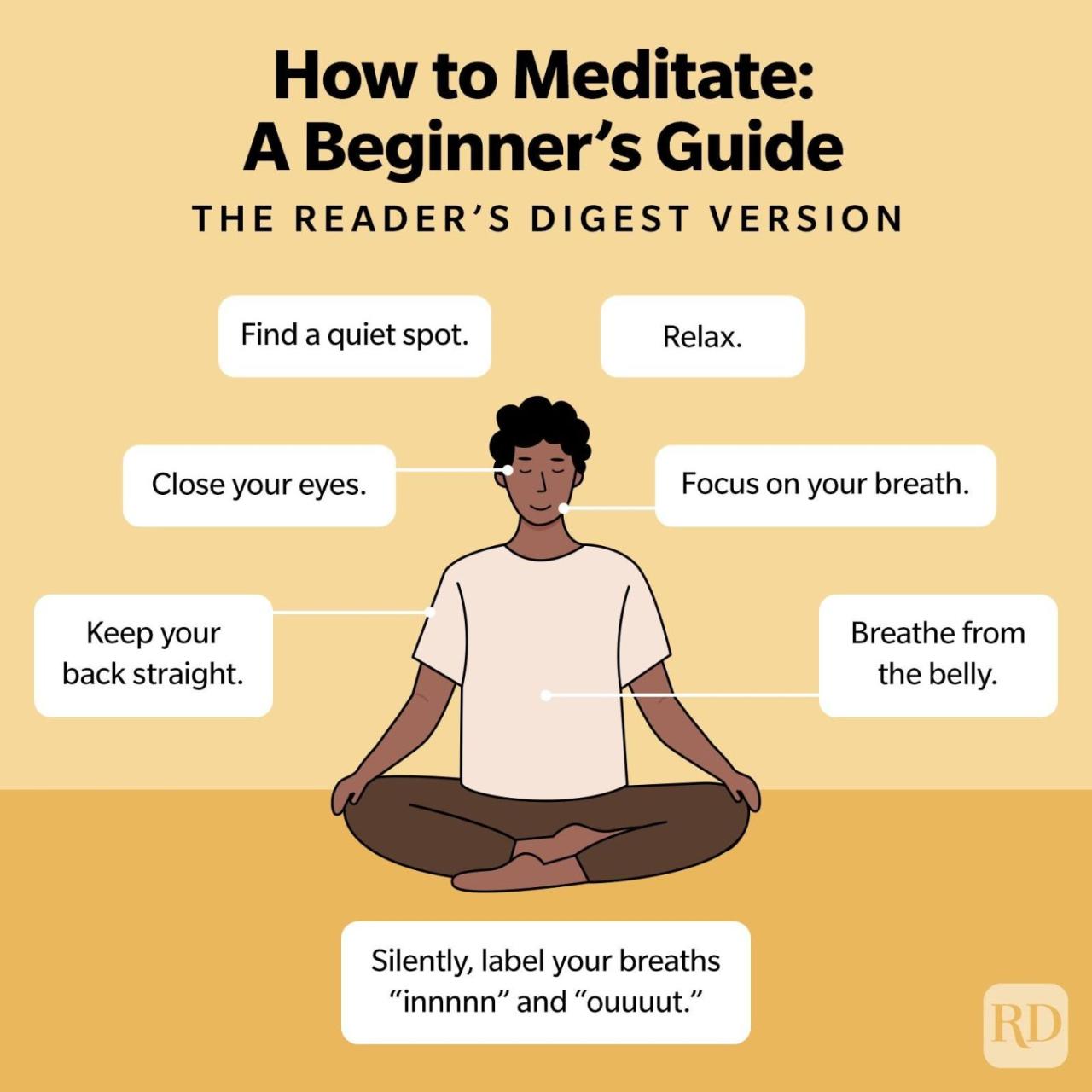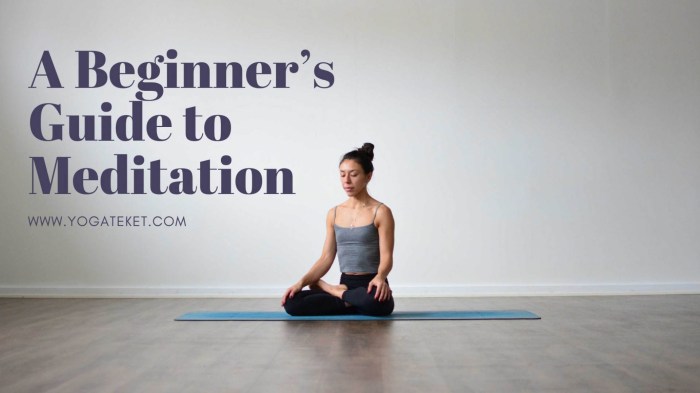Meditation for Beginners takes center stage, introducing you to the world of mindfulness in a fresh and exciting way. Get ready to embark on a journey of self-discovery and inner peace as we delve into the art of meditation.
Whether you’re a curious newbie or looking to enhance your well-being, this guide will equip you with the tools and knowledge to kickstart your meditation practice with confidence.
Introduction to Meditation for Beginners
Meditation is a practice that involves training the mind to focus and redirect thoughts. It is often done by sitting comfortably, closing the eyes, and focusing on breathing or a specific mantra.
Benefits of Practicing Meditation for Beginners
- Reduces stress and anxiety levels
- Improves concentration and focus
- Promotes emotional well-being
- Enhances self-awareness and mindfulness
- Increases inner peace and calmness
Why Meditation is Suitable for Individuals Starting their Meditation Journey
- Simple and easy to learn techniques
- No special equipment or prior experience required
- Can be practiced anywhere and at any time
- Helps beginners build a foundation for a regular meditation practice
Types of Meditation for Beginners

When starting out with meditation, beginners may find it helpful to explore different types of meditation practices to see what resonates best with them. Here are some common types of meditation suitable for beginners:
Mindfulness Meditation
Mindfulness meditation involves focusing on the present moment without judgment. Practitioners are encouraged to observe their thoughts, feelings, and sensations as they arise, allowing them to cultivate a sense of awareness and acceptance. Key characteristics of mindfulness meditation include focusing on the breath, body scan exercises, and loving-kindness practices. Benefits for beginners include stress reduction, improved focus, and increased self-awareness.
Guided Meditation
Guided meditation involves following the instructions of a teacher or recording to lead you through the meditation practice. This type of meditation is great for beginners who may find it challenging to meditate on their own. Guided meditations can cover a variety of topics such as relaxation, stress relief, and self-compassion. Benefits include easily accessible instructions, reduced anxiety, and enhanced visualization skills.
Mantra Meditation
Mantra meditation involves repeating a word, phrase, or sound to focus the mind and cultivate a sense of calm. Beginners can choose a mantra that resonates with them or follow traditional mantras like “Om” or “So Hum.” The repetition of the mantra helps to quiet the mind and deepen concentration. Benefits for beginners include increased concentration, reduced negative thinking patterns, and a sense of inner peace.
Overall, the key to finding the right type of meditation for beginners is to experiment with different practices and see what feels most comfortable and effective. Each type of meditation offers unique benefits that can support beginners on their journey to developing a regular meditation practice.
Setting Up a Meditation Space

Creating a peaceful meditation environment at home is essential for a successful practice. A quiet and comfortable space can help you focus and relax during your meditation sessions. Decorating your meditation space thoughtfully can further enhance your overall experience.
Tips for Creating a Peaceful Meditation Environment
- Choose a quiet area in your home where you won’t be disturbed.
- Use comfortable cushions or a meditation mat to sit on.
- Add elements like plants, candles, or incense to create a calming atmosphere.
- Consider playing soft music or nature sounds to drown out any distracting noises.
Importance of a Quiet and Comfortable Space
A quiet and comfortable space is crucial for meditation as it allows you to focus inward without external distractions. It helps you relax both mentally and physically, enabling a deeper connection with your practice.
Ideas for Decorating Your Meditation Space
- Hang tapestries or curtains to create a serene backdrop.
- Place a small fountain or a bowl of water for a soothing visual and auditory effect.
- Add cushions, blankets, or rugs for extra comfort during meditation.
- Use essential oils or diffusers to introduce calming scents like lavender or sandalwood.
Techniques for Beginners
Meditation can be a powerful tool for relaxation and stress relief, especially for beginners. Here are some basic techniques to help you get started on your meditation journey.
Deep Breathing
Deep breathing is a fundamental meditation technique that involves focusing on your breath to calm the mind and body. Here’s how to practice deep breathing effectively:
- Sit or lie down in a comfortable position.
- Close your eyes and take a deep breath in through your nose for a count of four.
- Hold your breath for a count of four.
- Exhale slowly through your mouth for a count of four.
- Repeat this cycle for several minutes, focusing on the sensation of your breath.
Body Scan
The body scan technique involves bringing awareness to each part of your body, helping you relax and release tension. Follow these steps to practice the body scan technique:
- Start at your toes and work your way up, paying attention to any sensations you feel in each body part.
- Notice any areas of tension or discomfort and imagine sending your breath to those areas to release the tension.
- Continue scanning your entire body, from your toes to the top of your head, staying present in the moment.
Visualization
Visualization is a technique that involves creating mental images to promote relaxation and focus. Here’s how to practice visualization during meditation:
- Close your eyes and imagine a peaceful place or scene that brings you comfort and calmness.
- Visualize yourself in that place, engaging all your senses to make the image as vivid as possible.
- Stay in this visualization for a few minutes, soaking in the positive energy and serenity of the scene.
Common Challenges and How to Overcome Them
As a beginner, you may encounter challenges during meditation. Here are some common obstacles and tips on how to overcome them:
- Difficulty focusing: If your mind wanders, gently bring your attention back to your breath or the present moment without judgment.
- Impatience: Remember that meditation is a practice, and progress takes time. Be patient with yourself and remain consistent in your practice.
- Physical discomfort: Adjust your position or take a break if you experience discomfort. Listen to your body’s needs and make adjustments as necessary.
Establishing a Meditation Routine
Establishing a consistent meditation routine is crucial for beginners to experience the full benefits of this practice. Consistency helps in developing focus, reducing stress, and promoting overall well-being.
Frequency and Duration
- Beginners should aim to meditate at least once a day to build a habit and see progress.
- Start with shorter sessions, around 5-10 minutes, and gradually increase the duration as you become more comfortable.
- It’s better to meditate for a short period consistently rather than having long sessions sporadically.
Integrating into Daily Routine
- Choose a specific time each day to meditate, such as in the morning before starting your day or in the evening before bed.
- Find a quiet and comfortable spot where you won’t be disturbed during your meditation practice.
- Consider using meditation apps or guided sessions to help you stay on track and make it a part of your daily routine.